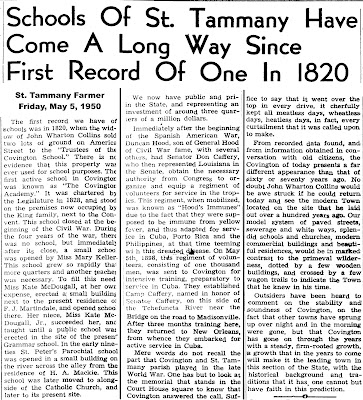The history of schools and education in St. Tammany Parish was the subject of a history article published in the St. Tammany Farmer in May of 1950. Here is a clipping of that article.
The text of the article can be found below:
St. Tammany Farmer Friday, May 5, 1950
Schools of St. Tammany Have Come a Long Way
The first record we have of schools was in 1820, when the widow of John Wharton Collins sold two lots of ground on America Street to the "Trustees of the Covington School." There is no evidence that this property was ever used for school purposes.
The first active school in Covington was known as "The Covington Academy." It was chartered by the Legislature in 1828, and stood on the premises now occupied by the King family, next to the Convent. This school closed at the beginning of the Civil War.
During the four years of the war, there was no school, brut immediately after its close, a small school was opened by Miss Mary Keller his school grew so rapidly that more quarters and another teacher was necessary. To fill this need Miss Kate McDougall, at her own expense, erected a small building next to the present residence of F. J. Martindale, and opened school there.
Her niece, Miss Kate McDougall, Jr., succeeded her, and taught until a public school was erected in the site of the present Grammar school. In the early nineties St. Peter's Parochial school was opened in a small building on the river across the alley from the residence of H. A. Mackie. This school was later moved to alongside of the Catholic Church, and later to its present site.
We now have public and private in the State, and representing an investment of around three quarters of a million dollars.
Hoods Immunes
Immediately after the beginning of the Spanish American War, Duncan Hood, son of General Hood of Civil War fame, with several others, had Senator Don Caffery, who then represented Louisiana in the Senate, obtain the necessary authority from Congress to organize and equip a regiment of volunteers for service in the tropics. This regiment, when mobilized, was known as "Hood's Immunes" due to the fact that they were supposed to be immune from yellow fever, and thus adapted for service in Cuba, Porto Rica and the Philippines, at that time teeming with this dreaded disease.
On May 5th, 1898, this regiment of volunteers, consisting of one thousand men, was sent to Covington for intensive training, preparatory to service in Cuba. They established Camp Caffery, named in honor of Senator Caffery, on this side of the Tchefuncta River near the bridge on the road to Madisonville. After three months training here, they returned to New Orleans, from whence they embarked for active service in Cuba.
World War One
Mere words do not recall the part that Covington and St. Tammany parish played in the late World War. One has but to look at the memorial that stands in the Court House square to know that Covington answered the call. Suffice to say that it went over the top in every drive, it cheerfully kept all meatless days, wheatless days, heatless days, in fact, every curtailment that it was called upon to make.
Covington of 1950
From recorded data found, and from information obtained in conversation with old citizens, the Covington of today presents a far different appearance than that of sixty or seventy years ago. No doubt John Wharton Collins would be awe struck if he could return, today and see the modern Town located on the site that he laid out over a hundred years ago.
Our model system of paved streets, sewerage and white ways, splendid schools and churches, modern commercial buildings and beautiful residences, would be in marked contrast to the primeval wilderness, dotted by a few wooden buildings, and crossed by a few wagon trails to indicate the Town that he knew in his time.
Outsiders have been heard to comment on the stability and soundness of Covington, on the fact that other towns have sprung up over night and in the morning were gone, but that Covington has gone on through the years with a steady, firm-rooted growth, is growth that in the years to come will make it the leading town in this section of the State, with the historical background and traditions that it has, one cannot but have faith in this prediction.
See also:


